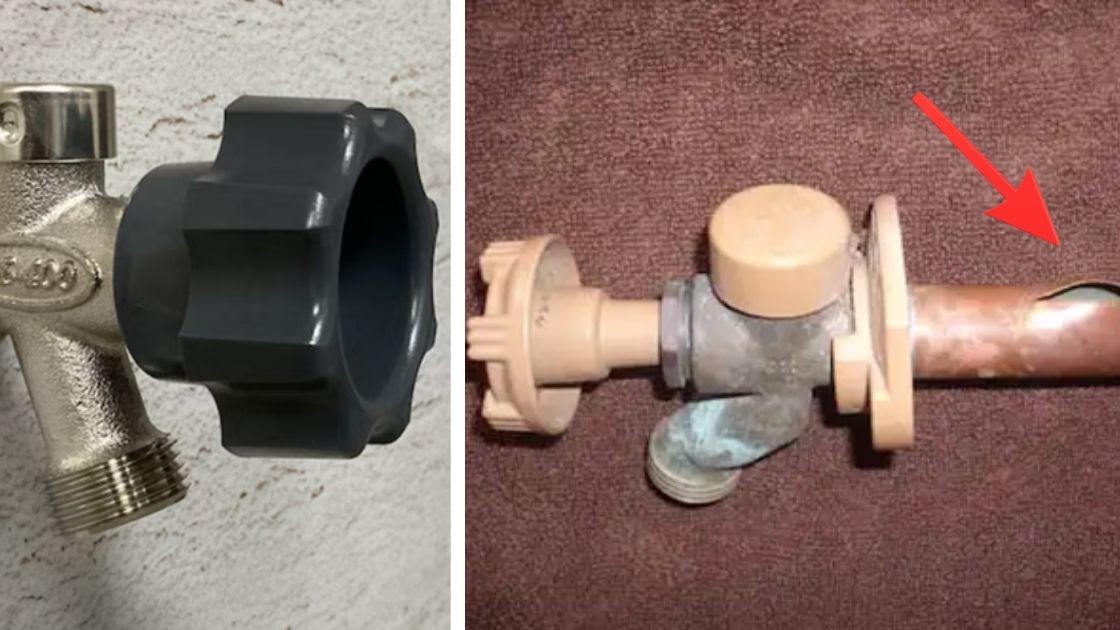-Matt Chandler, Master Plumber
If you had frost on your windshield recently, it is time to disconnect your hoses from your outdoor spigots. Every spring, we see a bunch of flooded basements and water leaks in the walls from frozen pipes. Here is how you can avoid this.
Do you have one of these (pictured above)?
This is called an Anti-Syphon Frost Free Hose Bib. These fixtures go flush to your outside wall, but they usually extend into the home 6-12”. When the valve is closed, they are designed to allow any remaining water in the faucet to drain out once the water valve is closed. Frost Free may sound like a guarantee against freezing, but unfortunately, it’s just the name of the design. They must have the hose disconnected every fall. If the hose is left on, the water cannot drain out. If water cannot drain, it freezes, expands, and will burst the sides of the piping. If you see a copper pipe that has split in the manner shown above, the only possible cause is ice damage.
So why don’t we see a bunch of water damage right away?
The design of a frost-free hose bib is such that the pressurized water is controlled all the way back, possibly a foot inside the house. The rubber washer that turns the water on and off is right where the piping connects to the faucet…Back before the split. What tends to happen is that people forget to disconnect their hoses. We’re busy, it’s an oversight…but it happens. The cold season sneaks up on us, then comes and goes. In March and April, everyone is excited about outdoor projects again. They may turn on the shut-off valve in the basement, to their outdoor spigot, and see nothing… No signs of leaks.
It’s when you go outside that the problem starts. When they turn on the spigot, water is now being let into the copper stubbed in through the side of the home… They may see nothing at first if the water is all contained within the garden hose and sprayer. Water may now be flowing inside, and you didn’t realize it. As soon as the outdoor hose is turned on, pressurized water is spraying into your walls and ceilings. Folks come back inside after a while of watering things, only to discover their basement is flooded.
So what’s the proper solution?
In early fall, disconnect your hose from the outdoor spigot. Next, go to your basement and find the shut-off valve to the spigot. Turn it off. Now go back outside and open the valve to let any remaining water out…And leave it open for the winter. This is the best process to maintain these fixtures and protect your home from a springtime flood.
What do you do if you have damage like this?
First, turn off the water to the area. Second, call your plumber, preferably PlumbPRO Services, because I like to think we’re a pretty phenomenal team. Third Photograph everything… Water-damaged areas, wet joists, & Insulation. If the hose bib has been cut out, or frost-damaged piping has been cut out, DO NOT DISCARD THE DAMAGED COPPER PIPING! The fourth would be to decide whether the damage is severe enough to require your insurance. In my experience, ice damage is the only time I have seen the failed piping covered along with the damaged property. Overall, it wasn’t your fault as the homeowner that it got so cold outside that the water froze. Don’t speculate on why it occurred with your insurance. Anything you say to insurance can and will be used against you. If a pipe froze and burst, and someone asks you why it failed. It’s because it got cold outside, which caused damage. Keep it short and sweet. If ever you find yourself in one of these situations, we can certainly help steer you in the right direction.
Thank you for taking the time to read this. I hope you and your family have a wonderful Thanksgiving and holiday season. Please keep us in mind for Plumbing, HVAC, & Drains!

Call or text: 484-222-0689
Book Online: http://www.PlumbPROServices.com

